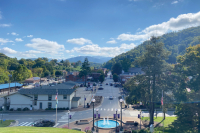Walnut toxicity
The walnut trees along the creek where we live are exhibiting a bumper crop this year. At night we are starting to hear their fruits dropping with heavy thuds on the ground or like depth charges into the water. Hopefully, one of them won’t conk me on the head when I’m working in the yard.
There are two walnut species native to Western North Carolina: butternut walnut (Juglans cinera) and black walnut (Juglans nigra). They are in the walnut family, which also includes six or so species of hickory. Butternut, also called white walnut, occurs as a non-dominant canopy species. It’s most often encountered in rich woodlands at middle and low elevations, often alongside streams. Shorter than black walnut, butternut branches are more widespread than its relative.
I can usually identify a butternut tree from some distance by its gray to light-brown bark, which is characteristically divided into deep furrows that form a rough diamond-shaped pattern. The conspicuous sulfur-yellow buds are apparent year-round. Its fruits are oval in shape. The meat inside the nuts is sweet but somewhat difficult to harvest.
Various green, brown, and black dyes were obtained from the leaves, bark, hulls, and roots of both butternut and walnut trees by the ancient Cherokees and early settlers. Pick up a butternut fruit and you’ll note a brown stain on your hands that’s sometimes difficult to wash off since this substance is a genuine dye. During the Civil War, backwoods Confederate troops dressed in homespun uniforms of butternut-dyed cloth that led to their being know as Butternuts.
Unfortunately, a canker has infested butternuts throughout its range so that this lovely little tree may soon be eradicated. The loss would not be as significant as was that of the American chestnut earlier in this century, but it would be more final. Chestnut continues to survive in a limited way via root sprouts that appear from persistent underground root systems – but, to my knowledge, butternut doesn’t root-sprout after being felled by the canker disease.
Black walnut grows at elevations up to almost 4,000 feet. Native old-growth stands are occasionally encountered. It attains heights of over 150 feet. Everyone recognizes the tree easily by its characteristic compound leaves, dark bark, and oval fruits. It provides one of the finest cabinet woods in North America and is also used extensively for custom-crafted gunstocks. Because of the demand for the wood of these slow-growing trees, the supply has been severely diminished; so much so, that remaining supplies are being used more for the production of veneer for cabinets and furniture than for solid items. The rich-tasting meat inside the nuts is a favorite of squirrels, and it is much in demand for use in candies and ice cream.
Related Items
Back in the late 1970s, my wife, Elizabeth, and I raised a large vegetable garden in a flat area up the creek from our home. For some years, we harvested from this quarter-acre plot a lot of the food that our family depended upon. The soil was fairly productive for most part, but the far side next to a mountain slope never would do well. Seeds often failed to germinate or, if they did, the resulting plants were mostly stunted and low yielding. We figured it was something in the soil. One day a neighbor pointed out that the trees growing on the slope with branches that overhung that edge of the garden were black walnuts.
“You can’t grow much of anything under a walnut,” he said. “It’s a tree that don’t like other plants, especially tomato plants.”
We conducted a little research and quickly established that our neighbor was correct. We found that black walnut produces a chemical called juglone, which occurs naturally in all parts of these plants. Why? Well, many plants exhibit protective devices like thorns or toxic substances that discourage predators such as grazing animals or insects. But other plants, like black walnut, exude alleopathic substances such as juglone that discourage or totally inhibit the growth of other plants. “Allelopathy” is the scientific term used to describe interactions whereby one plant produces a substance that affects the growth of another. It is, in other words, snuffing out the competition.
If you have to deal with black walnut trees in or adjacent to your gardening areas, your local extension agent will be able to provide literature and advice. There is also an excellent online site created by the Ministry of Agriculture and Food in Ontario, Canada, that explains “Walnut Toxicity” in detail and provides extensive lists of both agricultural and ornamental plants that will or will not tolerate juglone: http://www.omafra.gov.on.ca/english/crops/facts/info_walnut_toxicity.htm.
According to this site, “Experimentally, juglone has been shown to be a respiration inhibitor, which deprives sensitive plants of needed energy to enable metabolic activity. Affected plants cannot exchange carbon dioxide and oxygen properly. In affected tomatoes, xylem vessels become plugged by callus tissue, blocking upward movement of water in the plant. Symptoms of walnut toxicity range from stunting of growth, to partial or total wilting, to death of the affected plant. The toxic reaction often occurs quickly where sensitive plants can go from healthy to dead within one or two days. Many alarmed gardeners often believe the cause of wilting is due to fungal or bacterial disease. Once wilting begins, the effect cannot be reversed. Gardens should be located away from black walnut and butternut trees to prevent damage to susceptible plants. Where close proximity is unavoidable (a neighbors yard) then raised garden beds can provide some protection from juglone toxicity. Care must be taken to minimize or prevent walnut tree roots from growing upwards into the raised beds. Underlying a garden with plastic or fabric weed barrier during construction can prevent tree roots [which may extend up to 80 feet from the trunk] from growing into raised beds. Excellent soil drainage will also help reduce toxicity problems, even among sensitive plant species.”
George Ellison wrote the biographical introductions for the reissues of two Appalachian classics: Horace Kephart’s Our Southern Highlanders and James Mooney’s History, Myths, and Sacred Formulas of the Cherokees. In June 2005, a selection of his Back Then columns was published by The History Press in Charleston as Mountain Passages: Natural and Cultural History of Western North Carolina and the Great Smoky Mountains. Readers can contact him at P.O. Box 1262, Bryson City, N.C., 28713, or at This email address is being protected from spambots. You need JavaScript enabled to view it..









